 |
|
|
Начало : О нас : Наши партнеры : Статьи : WWW ресурсы : Обратная связь |
|
|
 |
|
To reproduce a photograph as a picture on paper requires two
optical imaging processes: One to put the image onto the film and one to enlarge the image
onto the paper. The second image reproduction process is no less important for the quality
of the final result than the first. When selecting your enlarging lens, you therefore need
to be just as critical as when you purchase your high-quality taking lens. In both cases,
only the best can be good enough.
|
[ top ] |
||
Rogonar | The low-priced starter for the amateur dark room |
||
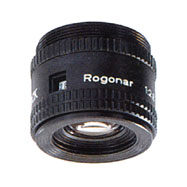 |
The Rogonar forms a solid base for the
"first steps" in amateur developing. This lens is already a standard feature of
many low-price enlarging units.
|
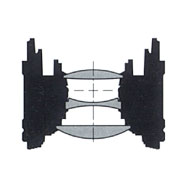 |
Rogonar-S | The lens with the optimal price performance ratio for standard prints |
||
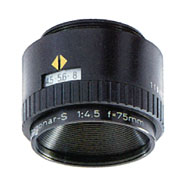 |
The universal lens Rogonar-S has a
relatively simple optical design and so a very attractive price. But the very high
performance capability of this lens make it ideal for the high requirements of demanding
amateurs or professional developing labs.
|
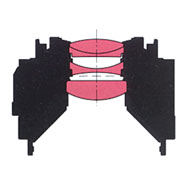 |
Rodagon | The all-round lens for professional quality in the developing lab |
||
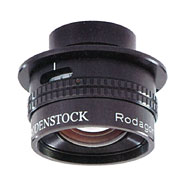 |
The lens type Rodagon, with brilliant
reproduction over the whole scale range of conventional enlargers, has become the
universal workhorse of both demanding amateurs and professionals in practical use.
|
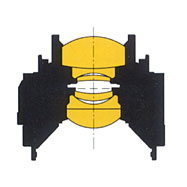 |
Rodagon-WA | Professional quality with a clearly smaller projection distance |
||
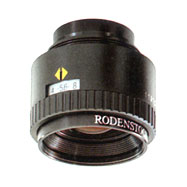 |
The Rodagon-WA has a shorter focal
length and a large angle of view and achieves a 70% larger projection area than
conventional enlarging lenses with standard focal lengths. It is therefore eminently
suitable for section enlargements on units with short columns. Clumsy wall or floor
projections can so be avoided.
|
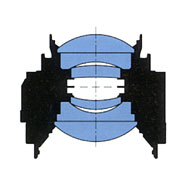 |
Apo-Rodagon-N | The unbeatable lens for the highest demands |
||
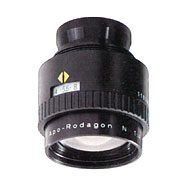 |
The apochromatically corrected
high-performance lenses of the Apo-Rodagon-N series guarantee perfect results which will
satisfy the highest demands.
|
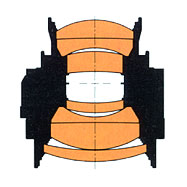 |
Rodagon-G | The special lens for large scales |
||
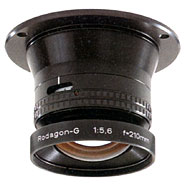 |
For wall-size multi-roll enlargements
and poster formats the Rodagon-G is the best choice: It has been optimised for extremely
large reproduction scales and surpasses the quality of all conventional enlarging lenses
for these scales. The 50 mm lens, for example, proves its superiority from scales of
around 15:1, while the Rodagon-G lenses with longer focal lengths demonstrate their class
from scales of around 10:1 or 8:1 (see table).
|
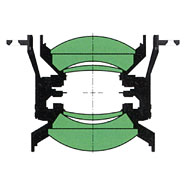 |
Apo-Rodagon-D | Duplication with practically no loss in quality |
||
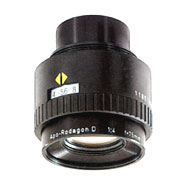 |
This lens is specialised for the
duplication of transparencies or for macro photographs at a reproduction scale of around
1:1.
|
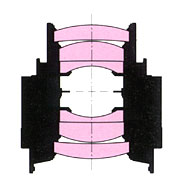 |
[ top ] |
|
|
|
1 |
Lens |
2 |
Max. recommended film size |
3 |
Recommended scale (optimal) |
4 |
Lowest aperture |
5 |
Pre-selection aperture |
6 |
Click-stop disable |
7 |
Illuminated stop display |
8 |
Filter thread, mm |
9 |
Flange focal length at infinity, mm |
10 |
Overal length, mm |
11 |
Maximum lens diameter, mm |
12 |
Screw thread, mm |
13 |
Contact area to rear edge, mm |
(to get a tip move the mouse pointer to column number) |
|
Rogonar |
||||||||||||
50 mm f/2,8 |
24x36mm |
2-8x (4x) |
16 |
|
|
+ |
- |
38,0 |
32,0 |
42,0 |
39,0 |
6,5 |
75 mm f/4,5 |
6x6cm |
2-6x (4x) |
16 |
|
|
+ |
- |
63,1 |
32,0 |
42,0 |
39,0 |
6,5 |
Rogonar-S |
||||||||||||
25 mm f/4,0 |
13x17mm |
10-30x (20x) |
16 |
|
|
|
30,5 |
23,0 |
28,0 |
40,5 |
32,5 |
4,5 |
35 mm f/4,0 |
18x24mm |
10-30x (20x) |
16 |
|
|
|
30,5 |
34,0 |
28,0 |
40,5 |
32,5 |
4,5 |
50 mm f/2,8 |
24x36mm |
2-10x (4x) |
16 |
+ |
+ |
+ |
40,5 |
47,0 |
37,5 |
50,0 |
39 |
6,5 |
60 mm f/4,5 |
40x40mm |
2-10x (4x) |
22 |
+ |
+ |
+ |
40,5 |
52,5 |
36,5 |
50,0 |
39 |
5,9 |
75 mm f/4,5 |
6x6cm |
2-10x (4x) |
22 |
+ |
+ |
+ |
40,5 |
65,5 |
36,5 |
50,0 |
39 |
5,9 |
90 mm f/4,5 |
6x7cm |
2-8x (4x) |
22 |
+ |
+ |
+ |
40,5 |
80,0 |
36,5 |
50,0 |
39 |
5,9 |
105 mm f/4,5 |
6x9cm |
2-8x (4x) |
22 |
+ |
+ |
+ |
40,5 |
95,0 |
36,5 |
50,0 |
39 |
5,9 |
135 mm f/4,5 |
9x12cm/4x5" |
2-6x (4x) |
32 |
|
|
+ |
52 |
129,5 |
38,0 |
60,0 |
50 |
11,3 |
150 mm f/4,5 |
9x12cm/4x5" |
2-6x (4x) |
32 |
|
|
+ |
52 |
138,0 |
36,8 |
60,0 |
50 |
9,8 |
Rodagon |
||||||||||||
28 mm f/4,0 |
18x24mm |
5-30x (20x) |
16 |
|
|
|
30,5 |
27,7 |
30,0 |
40,5 |
32,5 |
6,7 |
35 mm f/4,0 |
24x24mm |
5-30x (20x) |
16 |
|
|
|
30,5 |
35,6 |
32,5 |
40,5 |
32,5 |
9,0 |
50 mm f/2,8 |
24x36mm |
2-15x (10x) |
16 |
+ |
+ |
+ |
40,5 |
43,5 |
43,5 |
50,0 |
39,0 |
13,0 |
60 mm f/4,0 |
40x40mm |
2-10x (10x) |
22 |
+ |
+ |
+ |
40,5 |
56,0 |
41,0 |
50,0 |
39,0 |
10,0 |
80 mm f/4,0 |
6x7cm |
2-10x (6x) |
22 |
+ |
+ |
+ |
40,5 |
74,7 |
44,5 |
50,0 |
39,0 |
13,5 |
105 mm f/5,6 |
6x9cm |
2-10x (6x) |
32 |
+ |
+ |
+ |
40,5 |
99,5 |
41,0 |
50,0 |
39,0 |
10,5 |
135 mm f/5,6 |
9x12cm/4x5" |
2-10x (6x) |
32 |
+ |
+ |
+ |
40,5 |
128,0 |
45,5 |
50,0 |
39,0 |
14,5 |
150 mm f/5,6 |
9x12cm/4x5" |
2-10x (6x) |
45 |
|
|
+ |
52,0 |
146,0 |
49,8 |
60,0 |
50,0 |
20,1 |
180 mm f/5,6 |
13x18cm/5x7" |
2-8x (5x) |
45 |
|
|
+ |
58,0 |
177,0 |
59,8 |
60,0 |
50,0 |
24,6 |
210 mm f/5,6 |
13x18cm/5x7" |
2-8x (4x) |
45 |
|
|
+ |
67,0 |
201,0 |
67,2 |
70,0 |
58,0 |
28,1 |
240 mm f/5,6 |
18x24/8x10" |
2-8x (4x) |
45 |
|
|
+ |
77,0 |
230,0 |
77,0 |
80,0 |
72,0 |
30,0 |
300 mm f/5,6 |
18x24/8x10" |
2-8x (4x) |
45 |
|
|
+ |
86,0 |
283,0 |
93,0 |
90,0 |
72,0 |
8,5 |
360 mm f/6,3 |
24x30/10x12" |
2-8x (2,5x) |
45 |
|
|
+ |
95,0 |
300,0 |
110,6 |
100,0 |
90,0 |
9,5 |
Apo-Rodagon-N |
||||||||||||
50 mm f/2,8 |
24x36mm |
2-20x (10x) |
16 |
+ |
+ |
+ |
40,5 |
46,0 |
46,5 |
50,0 |
39,0 |
15,7 |
80 mm f/4,0 |
6x7cm |
2-15x (10x) |
22 |
+ |
+ |
+ |
40,5 |
77,0 |
43,0 |
50,0 |
39,0 |
12,2 |
105 mm f/4,0 |
6x9cm |
2-15x (6x) |
22 |
+ |
+ |
+ |
40,5 |
99,1 |
54,3 |
50,0 |
39,0 |
18,0 |
150 mm f/4,0 |
9x12cm/4x5" |
2-15x (6x) |
32 |
|
|
+ |
67,0 |
144,5 |
78,2 |
70,0 |
50,0 |
28,8 |
Rodagon-WA |
||||||||||||
40 mm f/4,0 |
24x36mm |
4-20x (10x) |
22 |
+ |
+ |
+ |
40,5 |
36,5 |
37,2 |
50,0 |
39,0 |
6,5 |
60 mm f/4,0 |
6x7cm |
4-15x (8x) |
22 |
+ |
+ |
+ |
40,5 |
55,5 |
41,0 |
50,0 |
39,0 |
10,0 |
80 mm f/4,0 |
6x9cm |
4-15x (8x) |
22 |
+ |
+ |
+ |
40,5 |
77,0 |
44,0 |
50,0 |
39,0 |
13,0 |
120 mm f/5,6 |
9x12cm/4x5" |
4-15x (6x) |
45 |
|
|
+ |
52,0 |
116,4 |
59,0 |
60,0 |
50,0 |
26,6 |
Rodagon-G |
||||||||||||
50 mm f/2,8 |
24x36mm |
15-50x (25x) |
16 |
+ |
+ |
+ |
40,5 |
47,0 |
45,0 |
50,0 |
39,0 |
14,0 |
105 mm f/5,6 |
6x9cm |
10-40x (20x) |
45 |
|
|
+ |
40,5 |
100,3 |
38,0 |
60,0 |
50,0 |
14,3 |
150 mm f/5,6 |
9x12cm/4x5" |
10-40x (20x) |
45 |
|
|
+ |
49,0 |
141,8 |
50,6 |
60,0 |
50,0 |
20,5 |
210 mm f/5,6 |
13x18cm/5x7" |
8-30x (20x) |
45 |
|
|
+ |
67,0 |
179,5 |
65,9 |
74,5 |
72,0 |
8,5 |
240 mm f/5,6 |
13x18cm/5x7" |
8-30x (20x) |
45 |
|
|
+ |
77,0 |
230,6 |
76,9 |
80,0 |
72,0 |
32,2 |
300 mm f/5,6 |
18x24/8x10" |
8-30x (20x) |
45 |
|
|
+ |
86,0 |
253,3 |
93,5 |
93,5 |
90,0 |
11,5 |
360 mm f/6,8 |
18x24/8x10" |
8-30x (20x) |
45 |
|
|
+ |
105,0 |
304,2 |
116,5 |
110,0 |
90,0 |
12,2 |
480 mm f/8,4 |
24x30/10x12" |
8-30x (20x) |
64 |
|
|
+ |
112,0 |
412,0 |
146,8 |
115,0 |
110,0 |
17,7 |
Apo-Rodagon-D |
||||||||||||
75 mm f/4,0 |
6x6cm |
0,9-1,2 (1x) |
22 |
+ |
+ |
|
40,5 |
136,7 (1:1) |
53 0 |
50,0 |
39,0 |
18,7 |
24x36mm |
0,7-1,5x (1x) |
|||||||||||
120 mm f/5,6 |
|
0,5-3x (2x) |
|
|
|
|
|
|
|
|
|
|
[ top ] |
|
Copyright: пїЅ Rodenstock
Prazisionsoptik GmbH - Photo and Vision Systems |
Copyright: пїЅ ProGraf, 2000 |